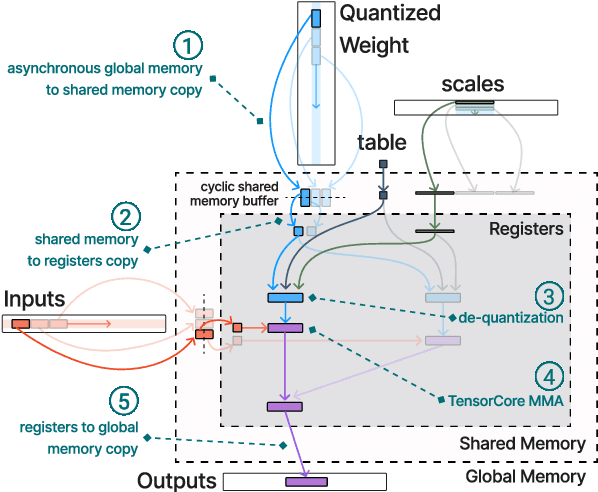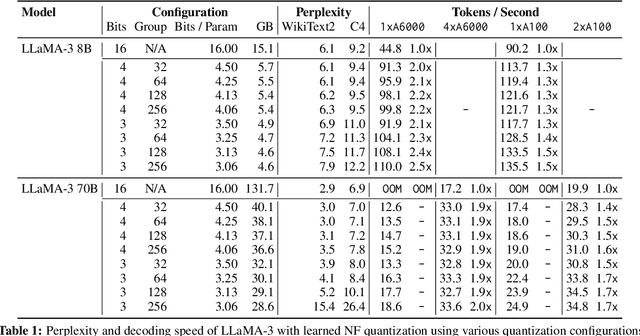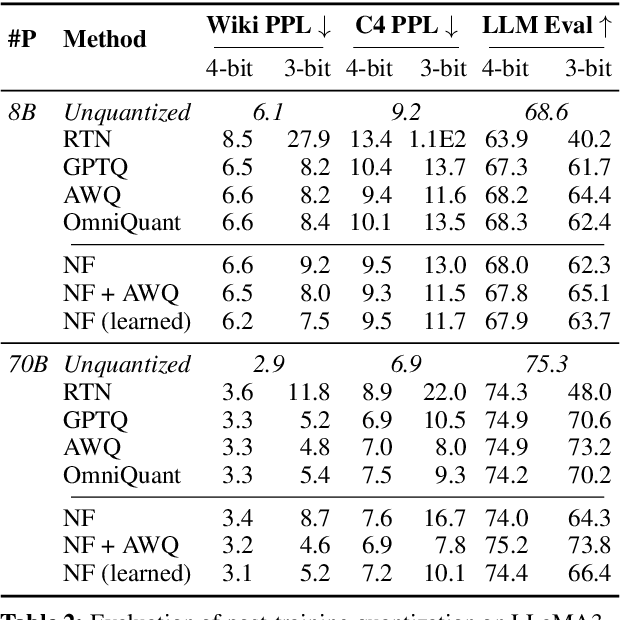Jonathan Ragan-Kelley
FlashFormer: Whole-Model Kernels for Efficient Low-Batch Inference
May 28, 2025Abstract:The size and compute characteristics of modern large language models have led to an increased interest in developing specialized kernels tailored for training and inference. Existing kernels primarily optimize for compute utilization, targeting the large-batch training and inference settings. However, low-batch inference, where memory bandwidth and kernel launch overheads contribute are significant factors, remains important for many applications of interest such as in edge deployment and latency-sensitive applications. This paper describes FlashFormer, a proof-of-concept kernel for accelerating single-batch inference for transformer-based large language models. Across various model sizes and quantizations settings, we observe nontrivial speedups compared to existing state-of-the-art inference kernels.
Learning to Keep a Promise: Scaling Language Model Decoding Parallelism with Learned Asynchronous Decoding
Feb 17, 2025Abstract:Decoding with autoregressive large language models (LLMs) traditionally occurs sequentially, generating one token after another. An emerging line of work explored parallel decoding by identifying and simultaneously generating semantically independent chunks of LLM responses. However, these techniques rely on hand-crafted heuristics tied to syntactic structures like lists and paragraphs, making them rigid and imprecise. We present PASTA, a learning-based system that teaches LLMs to identify semantic independence and express parallel decoding opportunities in their own responses. At its core are PASTA-LANG and its interpreter: PASTA-LANG is an annotation language that enables LLMs to express semantic independence in their own responses; the language interpreter acts on these annotations to orchestrate parallel decoding on-the-fly at inference time. Through a two-stage finetuning process, we train LLMs to generate PASTA-LANG annotations that optimize both response quality and decoding speed. Evaluation on AlpacaEval, an instruction following benchmark, shows that our approach Pareto-dominates existing methods in terms of decoding speed and response quality; our results demonstrate geometric mean speedups ranging from 1.21x to 1.93x with corresponding quality changes of +2.2% to -7.1%, measured by length-controlled win rates against sequential decoding baseline.
Ladder-residual: parallelism-aware architecture for accelerating large model inference with communication overlapping
Jan 11, 2025



Abstract:Large language model inference is both memory-intensive and time-consuming, often requiring distributed algorithms to efficiently scale. Various model parallelism strategies are used in multi-gpu training and inference to partition computation across multiple devices, reducing memory load and computation time. However, using model parallelism necessitates communication of information between GPUs, which has been a major bottleneck and limits the gains obtained by scaling up the number of devices. We introduce Ladder Residual, a simple architectural modification applicable to all residual-based models that enables straightforward overlapping that effectively hides the latency of communication. Our insight is that in addition to systems optimization, one can also redesign the model architecture to decouple communication from computation. While Ladder Residual can allow communication-computation decoupling in conventional parallelism patterns, we focus on Tensor Parallelism in this paper, which is particularly bottlenecked by its heavy communication. For a Transformer model with 70B parameters, applying Ladder Residual to all its layers can achieve 30% end-to-end wall clock speed up at inference time with TP sharding over 8 devices. We refer the resulting Transformer model as the Ladder Transformer. We train a 1B and 3B Ladder Transformer from scratch and observe comparable performance to a standard dense transformer baseline. We also show that it is possible to convert parts of the Llama-3.1 8B model to our Ladder Residual architecture with minimal accuracy degradation by only retraining for 3B tokens.
Fast Matrix Multiplications for Lookup Table-Quantized LLMs
Jul 15, 2024



Abstract:The deployment of large language models (LLMs) is often constrained by memory bandwidth, where the primary bottleneck is the cost of transferring model parameters from the GPU's global memory to its registers. When coupled with custom kernels that fuse the dequantization and matmul operations, weight-only quantization can thus enable faster inference by reducing the amount of memory movement. However, developing high-performance kernels for weight-quantized LLMs presents substantial challenges, especially when the weights are compressed to non-evenly-divisible bit widths (e.g., 3 bits) with non-uniform, lookup table (LUT) quantization. This paper describes FLUTE, a flexible lookup table engine for LUT-quantized LLMs, which uses offline restructuring of the quantized weight matrix to minimize bit manipulations associated with unpacking, and vectorization and duplication of the lookup table to mitigate shared memory bandwidth constraints. At batch sizes < 32 and quantization group size of 128 (typical in LLM inference), the FLUTE kernel can be 2-4x faster than existing GEMM kernels. As an application of FLUTE, we explore a simple extension to lookup table-based NormalFloat quantization and apply it to quantize LLaMA3 to various configurations, obtaining competitive quantization performance against strong baselines while obtaining an end-to-end throughput increase of 1.5 to 2 times.
WatChat: Explaining perplexing programs by debugging mental models
Mar 08, 2024Abstract:Often, a good explanation for a program's unexpected behavior is a bug in the programmer's code. But sometimes, an even better explanation is a bug in the programmer's mental model of the language they are using. Instead of merely debugging our current code ("giving the programmer a fish"), what if our tools could directly debug our mental models ("teaching the programmer to fish")? In this paper, we apply ideas from computational cognitive science to do exactly that. Given a perplexing program, we use program synthesis techniques to automatically infer potential misconceptions that might cause the user to be surprised by the program's behavior. By analyzing these misconceptions, we provide succinct, useful explanations of the program's behavior. Our methods can even be inverted to synthesize pedagogical example programs for diagnosing and correcting misconceptions in students.
Hydra: Sequentially-Dependent Draft Heads for Medusa Decoding
Feb 07, 2024Abstract:To combat the memory bandwidth-bound nature of autoregressive LLM inference, previous research has proposed the speculative decoding framework. To perform speculative decoding, a small draft model proposes candidate continuations of the input sequence, that are then verified in parallel by the base model. One way to specify the draft model, as used in the recent Medusa decoding framework, is as a collection of light-weight heads, called draft heads, that operate on the base model's hidden states. To date, all existing draft heads have been sequentially independent, meaning that they speculate tokens in the candidate continuation independently of any preceding tokens in the candidate continuation. In this work, we propose Hydra heads, a sequentially dependent, drop-in replacement for standard draft heads that significantly improves speculation accuracy. Decoding with Hydra heads improves throughput compared to Medusa decoding with standard draft heads. We further explore the design space of Hydra head training objectives and architectures, and propose a carefully-tuned Hydra head recipe, which we call Hydra++, that improves decoding throughput by 1.31x and 2.71x compared to Medusa decoding and autoregressive decoding, respectively. Overall, Hydra heads are a simple intervention on standard draft heads that significantly improve the end-to-end speed of draft head based speculative decoding.
How to guess a gradient
Dec 07, 2023Abstract:How much can you say about the gradient of a neural network without computing a loss or knowing the label? This may sound like a strange question: surely the answer is "very little." However, in this paper, we show that gradients are more structured than previously thought. Gradients lie in a predictable low-dimensional subspace which depends on the network architecture and incoming features. Exploiting this structure can significantly improve gradient-free optimization schemes based on directional derivatives, which have struggled to scale beyond small networks trained on toy datasets. We study how to narrow the gap in optimization performance between methods that calculate exact gradients and those that use directional derivatives. Furthermore, we highlight new challenges in overcoming the large gap between optimizing with exact gradients and guessing the gradients.
Striped Attention: Faster Ring Attention for Causal Transformers
Nov 15, 2023Abstract:To help address the growing demand for ever-longer sequence lengths in transformer models, Liu et al. recently proposed Ring Attention, an exact attention algorithm capable of overcoming per-device memory bottle- necks by distributing self-attention across multiple devices. In this paper, we study the performance characteristics of Ring Attention in the important special case of causal transformer models, and identify a key workload imbal- ance due to triangular structure of causal attention computations. We propose a simple extension to Ring Attention, which we call Striped Attention to fix this imbalance. Instead of devices having contiguous subsequences, each device has a subset of tokens distributed uniformly throughout the sequence, which we demonstrate leads to more even workloads. In experiments running Striped Attention on A100 GPUs and TPUv4s, we are able to achieve up to 1.45x end-to-end throughput improvements over the original Ring Attention algorithm on causal transformer training at a sequence length of 256k. Furthermore, on 16 TPUv4 chips, we were able to achieve 1.65x speedups at sequence lengths of 786k. We release the code for our experiments as open source
The Cost of Down-Scaling Language Models: Fact Recall Deteriorates before In-Context Learning
Oct 07, 2023



Abstract:How does scaling the number of parameters in large language models (LLMs) affect their core capabilities? We study two natural scaling techniques -- weight pruning and simply training a smaller or larger model, which we refer to as dense scaling -- and their effects on two core capabilities of LLMs: (a) recalling facts presented during pre-training and (b) processing information presented in-context during inference. By curating a suite of tasks that help disentangle these two capabilities, we find a striking difference in how these two abilities evolve due to scaling. Reducing the model size by more than 30\% (via either scaling approach) significantly decreases the ability to recall facts seen in pre-training. Yet, a 60--70\% reduction largely preserves the various ways the model can process in-context information, ranging from retrieving answers from a long context to learning parameterized functions from in-context exemplars. The fact that both dense scaling and weight pruning exhibit this behavior suggests that scaling model size has an inherently disparate effect on fact recall and in-context learning.
Differentiating Metropolis-Hastings to Optimize Intractable Densities
Jun 30, 2023Abstract:We develop an algorithm for automatic differentiation of Metropolis-Hastings samplers, allowing us to differentiate through probabilistic inference, even if the model has discrete components within it. Our approach fuses recent advances in stochastic automatic differentiation with traditional Markov chain coupling schemes, providing an unbiased and low-variance gradient estimator. This allows us to apply gradient-based optimization to objectives expressed as expectations over intractable target densities. We demonstrate our approach by finding an ambiguous observation in a Gaussian mixture model and by maximizing the specific heat in an Ising model.
 Add to Chrome
Add to Chrome Add to Firefox
Add to Firefox Add to Edge
Add to Edge